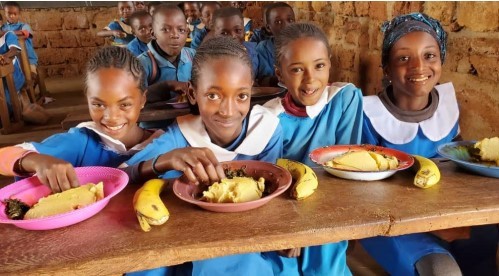Pupils enjoying WFP-provided meals at school (photo credit: WFP)
By Nformi Sonde Kinsai
Despite the fluctuating figures from 2018 to 2024 of children in the school feeding programme supported by the World Food Programme (WFP) through the government of Cameroon, the number of beneficiaries is generally on an upward trend.
The information is contained in a school feeding factsheet spanning 2018 to 2024 provided to the media by WFP during the recent official validation in Yaounde of the National School Feeding Strategy 2025-2030 and the Sustainable Finance Strategy for School Feeding in Cameroon. The programme is under the auspices of the Ministry of Basic Education, MINEDUB.
The WFP Representative and Country Director for Cameroon and Sao Tome & Principe, Gianluca Ferrera, declared at the event that the collective objective of stakeholders involved in the school feeding programme remains clear – guarantee 1 million pupils across the country daily access to a safe, nutritious meal of local origin by 2030.
Meanwhile, the school feeding factsheet covering the Adamawa, Centre, East, Far North, North, Northwest, and Southwest regions reveals that in 2018 WFP fed 76 000 pupils in 134 schools; 75,583 in 136 schools in 2019; 70 457 in 138 schools in 2020; 82 315 in 177 schools in 2021; 74 752 in 151 schools in 2022; 69 732 in 103 schools in 2023; and 103 953 pupils in 154 schools in 2024.
It is stated that in 2024, WFP continued to implement school feeding in emergencies in 47 schools across the Far North region, while the Home-Grown School Feeding (HGSF) programme expanded significantly, reaching 71,850 pupils, with 43 percent of them being girls, in 107 schools in the seven regions cited above. The meals provided to the pupils varied according to local eating habits and type of foodstuff available.
During the COVID-19 pandemic, WFP supported households with take-home rations to encourage school attendance. In 2022, WFP resumed the distribution of daily on-site school meals while piloting the HGSF initiative in the East and Adamawa regions.
According to the factsheet, the initiative expanded significantly in 2024 due to funding from the Cameroon Government through the World Bank funding mechanism to finance the emergency project for the fight against food insecurity (PULCCA). The school feeding initiative, as an unintended consequence, highlighted the problem of the lack of birth certificates for nearly 46 percent of pupils in the targeted schools. Thanks to WFP’s support, the civil status office, the local councils, and the prosecutor’s office are collaborating to issue birth certificates, allowing learners to sit for their examinations.
As a result of repeated shocks in Cameroon, vulnerable populations have been pushed into deteriorating food and nutrition insecurity, with hunger negatively impacting children’s ability to enroll, attend and remain in school. School meals have thus helped families to support their children’s education while protecting their food security. “They help break the cycle of hunger and poverty by increasing the chances of children becoming healthy and productive adults,” the factsheet notes.
In a context justification, the factsheet holds that as a result of the humanitarian crises, 1.5 million children in Cameroon are in dire need of humanitarian educational support. In areas hit by high insecurity, thousands of schools and community learning spaces have been closed. In addition, families lack the resources to support their children’s education, and the incentives for children to participate in low-skilled jobs are higher than keeping them in schools.
“Consequently, educational outcomes such as enrolment, retention, completion, and transition from primary to secondary school remain low. Less than 60 percent of students transition from primary into secondary schools, and 25% of students do not graduate from primary school,” the document reveals.
WFP, for example, states that significant gaps exist between the enrolment rate of boys and girls in the Adamawa and East regions. The main challenges to access to education for girls and women in these regions are blamed on early marriages and teenage pregnancies, amongst others.
In the Far North Region, the humanitarian situation has a severe impact on children’s access to and retention in school. “Insecurity, inter-community clashes and floods have led to the destruction and closure of hundreds of schools, compounded by socio-cultural norms that hinder families from prioritising education, with 564 000 school-age children in need of educational assistance in the region.
On the other hand, as a result of the socio-political crisis in the Northwest and Southwest regions, thousands of schools remain closed, and 865 000 children require access to educational services. The persistent attacks by non-state armed groups on education facilities render the provision of humanitarian assistance very challenging.
It is worth noting that WFP has been implementing school feeding activities in Cameroon since 1978.

